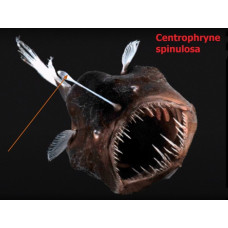The Laina name illicium is from illicio 'to lure, entice'.
Illicium is a modified first ray of the dorsal fin, which turns into a kind of "fishing rod" in female deep-sea anglers.
A special catching protrusion ("rod") on the top of the head in bony fishes of the Lophiiformes, used to lure prey.
Illicium is a modified first ray of the dorsal fin, which is displaced to the front end of the body to the upper jaw and turned into a kind of "fishing rod", ending with a leathery pouch "bait" (eska), which in different species varies greatly in shape and size and is equipped with a variety of skin growths and appendages.
In most deep-sea representatives of the suborder Ceratioidei, the esca is a gland filled with mucus in which bioluminescent bacteria are enclosed. It is assumed that they have developed a symbiotic relationship and the bacteria are incapable of independently synthesizing all the chemicals required for luminescence. Electron microscopy of these bacteria from some species shows that they are Gram-negative bacilli that lack capsules, spores or flagella. They have bilayered cell walls and mesosomes. Numerous pores connect the esca cavity to seawater, which allows the removal of dead bacteria and cellular waste products and the maintenance of constant pH and culture medium conditions. These parameters, along with the constant temperature of the bathypelagic zone inhabited by these fish, are critical to the long-term viability of these bacterial cultures.
It is assumed that due to the widening of the lumen of blood vessels that supply the esca with blood, fish can arbitrarily cause the glow of bacteria that need for this purpose in the supply of oxygen, or stop it by narrowing the vessels. Usually the glow occurs as a series of consecutive flashes, the nature and sequence of which is individual for each species.
Illicium of different species varies in shape and size and is provided with different skin appendages. Among representatives of Ceratioidei it is characteristic only for females, while males are deprived of it. In females of most species of illichium is short, but in individuals of some genera (Rhynchactis, Lasiognathus and Gigantactis) it is very long and can be many times longer than the body length of the fish itself. For example, in Paroneirodes wedli illichium exceeds body length 1,1-1,4 times, and in Gigantactis macronema it exceeds body length 4 times. The illichium of Ceratias holboelli has a strongly elongated basal part and is able to extend and retract into a special channel, luring prey to the fish, which gradually moves the luminescent esca to the mouth until it swallows the victim. In Lasiognathus saccostoma, the initial part of the illichium has the appearance of a long rod that is able to retract into a special vagina, while its terminal part is thin and flexible and crowned with an esca with three hooks.
In contrast to majority of representatives of deep-water oystercatchers, females of the genus Knotorhynchus oystercatchers have no esca with bioluminescent bacteria on illichium. In representatives of the family Antennariidae and of the order Uglypods illichium varies in shape and size and is equipped with different skin appendages, but at the same time its esca is also deprived of bioluminescent bacteria. In members of the family Chaunacidae, the illicium is located just behind the mouth on an ovoid area of skin without scales or in a recess into which it can retract. Esca with numerous short, densely seated filaments.
Illicium
Tags: illicium


